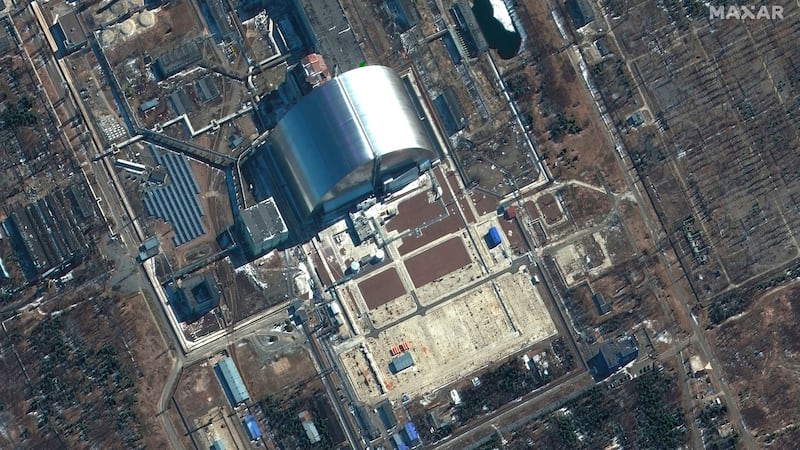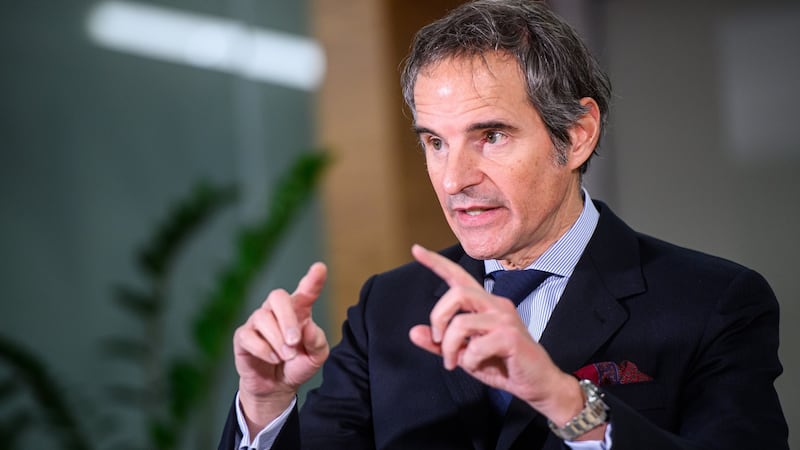Blatant disregard for the safety of the Chernobyl and Zaporizhzhia nuclear power plants in Ukraine must rank high on the scale of Russia's mad, bad and dangerous behaviour since February 24th.
Russian troops took Chernobyl in north-central Ukraine, the site of the worst nuclear disaster in history, on the first day of the war. They shelled the Zaporizhzhia plant in the southeast, the biggest in Europe, just over a week later, starting a fire that damaged equipment.
US president Joe Biden termed the shelling of Zaporizhzhia "reckless", surely an understatement.
"They even threatened to cause an explosion, to destroy the plant," says Anatoliy Nosovsky, a nuclear physicist who trained in Leningrad, Odesa and Kyiv and serves as director of the institute for nuclear safety at the Ukrainian academy of science.
“They are blackmailing us with radioactive material. This is nuclear terrorism,” says Nosovksy over video from his home in Kyiv.
"If the water is low, hydrogen may rise, and it takes just one spark to explode and that could lead to a disaster like what happened at Fukushima"
Two-hundred tonnes of radioactive waste, the core of the reactor that exploded on April 26th, 1986, have been encased in a lead and concrete sarcophagus at Chernobyl. The complex also contains 20,000 used nuclear fuel assemblies, which are stored in cooling ponds. Electricity is needed to pump water into the ponds. Repeated power outages after the Russian seizure lowered water levels.
"If the water is low, hydrogen may rise, and it takes just one spark to explode and that could lead to a disaster like what happened at Fukushima," says Nosovsky, referring to the 2011 disaster caused by an earthquake in Japan.
That would be the worst-case scenario, says Nosovsky. “They could also destroy the steel and concrete confinement of a reactor through shelling and bombing. Radioactive dust might spread many kilometres on the wind.”
An engineer at Chernobyl told Agence France Presse that the pool where spent fuel is stocked is “overpacked by 40 per cent” and “back-up pools should be empty, but they are also filled with other spent fuel”. She said the situation was “against all international safety regulations.”
Safety improvements
Nosovsky excludes the possibility of a leak on the scale of 1986. Nuclear safety has improved a great deal since then, he says. "We calculated what would happen if a confinement collapsed. We studied the wind and dust storms. We concluded that 30km would be the potential disaster range, but radioactivity could contaminate the river and a large part of Belarus. "
The scientists who designed Ukraine's nuclear power plants considered every possible disaster, says Nosovsky. "Earthquakes, floods, tornadoes. But no one ever imagined a military onslaught by Russia. We have many nuclear power plants, and they are not built to withstand acts of war."
"We had samples of radioactive material in these labs, and a lot of equipment there was contaminated. Even if they are complete morons, they should understand that these are not toys"
Ukraine is the world’s seventh-largest producer of nuclear power, with 15 plants and three spent-fuel storage facilities. Nosovsky is particularly worried that a neutron reactor in the eastern city of Kharkiv and a research reactor in Kyiv could be shelled or bombed.
About 211 staff, including technicians, security guards and medical personnel, had completed the overnight shift when the war started. Bridges over the river Dnieper were destroyed. Staff could not leave the plant, nor would the Russians let them.
“Staff also refused to leave because they don’t trust the Russians to replace them with qualified personnel,” says Nosovsky, who left the Chernobyl lab of the institute for nuclear safety with his employees hours before the Russians’ arrival. “They said they would stay. It was very heroic of them.”

The Chernobyl staff have endured terrible conditions for the past 3½ weeks. They had no soap, shampoo, medicine or toothpaste and could not change clothes. The plant has no beds, so employees have had to sleep on hard floors, desks or chairs. The Russians confiscated personal telephones, and staff could call home only on a landline monitored by the Russians. They also feared being irradiated in the event of a nuclear accident.
On March 13th, several dozen family members staged a protest in Slavutych, the town that was built for Chernobyl staff. “Our boys are not just hostages but prisoners in a Russian concentration camp,” a woman at the protest told local television.
The Russians finally allowed 64 of the plant staff to depart on March 20th. They were taken home by fishing boats on the Dnieper, and replaced by 46 volunteers. "It is a positive – albeit long overdue – development that some staff at the Chernobyl nuclear power plant have now rotated and returned to their families," Rafael Grossi, the director of the International Atomic Energy Agency said in a statement. "They were there for far too long. I sincerely hope that remaining staff from this shift can also rotate soon."
Power supply
Nosovsky accuses Russian troops of vandalising Chernobyl. “They have stolen computers, office and laboratory equipment. They looted supplies. We had samples of radioactive material in these labs, and a lot of equipment there was contaminated. We don’t know what happened to these things, where they took them or what they will do with them ... There are many signs in the plant. They should have known these things were radioactive and dangerous. Even if they are complete morons, they should understand that these are not toys.”
Russia’s motives in seizing the two nuclear plants are not clear. They may simply want to terrorise Ukrainians, as Nosovsky suggests. More than 50 per cent of Ukraine’s electricity comes from nuclear plants, so controlling them also enables the invaders to manipulate the power supply.
"They used the false claim that we had a secret nuclear programme to justify the invasion and the seizure of the plants. I went on television to refute this absurd accusation"
A relative of a technician at the plant says the Russians have transformed Chernobyl into a military base with missile launchers. The Russians may see the power plants as unassailable fortresses, since neither the Ukrainians nor Nato – should it ever join the war – would dare attack a nuclear installation.
In the run-up to the invasion, Russia accused Ukraine of wanting to divert nuclear waste to create a “dirty bomb” or conventional weapon doped with radioactive material. The accusation enrages Nosovsky.
"This was part of their propaganda," he says. "They used the false claim that we had a secret nuclear programme to justify the invasion and the seizure of the plants. I went on television to refute this absurd accusation. All our facilities are constantly monitored by the IAEA [International Atomic Energy Agency]. There is no hidden activity. Jason Tierney, the head of nuclear security at the IAEA, confirmed there was no evidence that Ukraine intended to create a dirty bomb."

Nosovsky would have liked the UN’s nuclear watchdog to have been more vehement in its denunciation of Russia’s actions. “They merely expressed concern. They ought to condemn the Russian aggression. They ought to call Russia nuclear terrorists. They did nothing.”
He attributes the IAEA's relative passivity to the fact that Russia helps fund the agency, and that Mikhail Chudakov, a Russian citizen, is a deputy director general and heads the department of nuclear energy.
Nosovsky hopes the war will lead to an international ban on all military activity within 30km of nuclear power plants, “though you have to realise that even if we had such rules, sick people would not comply”.
The war should also result in a re-examination of Russia's role in UN bodies, in particular the IAEA and the Security Council, he says.


















